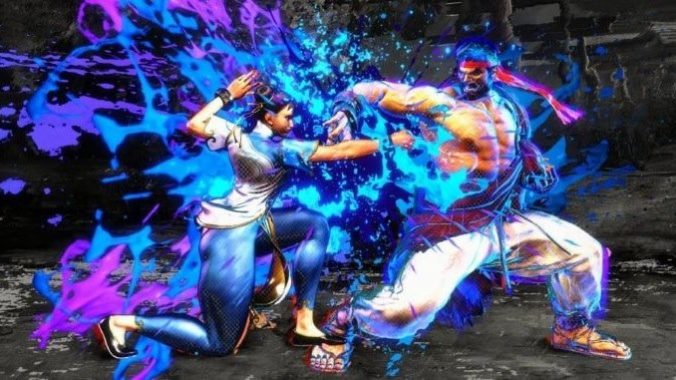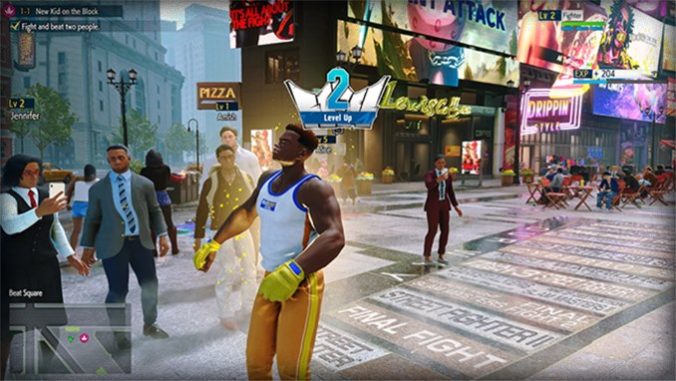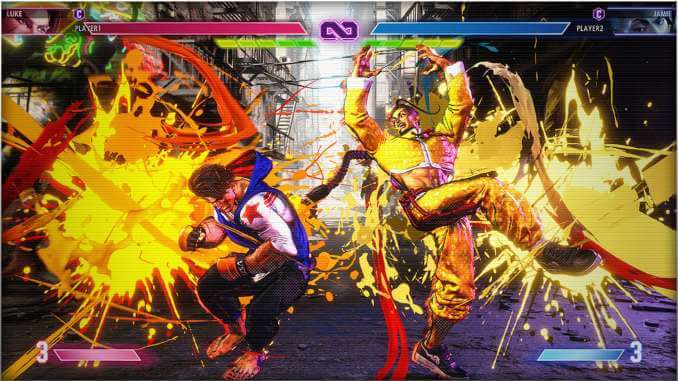
Street Fighter 6 is my favorite RPG of the year so far. I don’t even know what to make of that. The game built around roughhousing with your buddies and losing your quarters to the sharks down at the arcade has dived into Yakuza territory with a lengthy role-playing game set in the mean streets of Metro City (among other locales). In the past playing Street Fighter alone meant endless tourneys with the computer or, more recently, getting destroyed online by some random middle schooler with the tag Akuma69420. In Street Fighter 6’s World Tour mode you’ll spend a lot of time fighting with the computer, but with an actual storyline and sense of progression to keep you motivated.
Earlier this month I wrote about how much I loved the taste of World Tour we got in the game’s demo. As eye-opening as that demo was, it didn’t give much of a sense of how massive World Tour would be. Expect to put at least two dozen hours into it, between following the story and grinding to boost your levels. With multiple locations to travel to, a roster full of fighters to learn from, and a surprisingly political story focused on capitalist colonialism and the sometimes predatory nature of the charity industry, World Tour is a sprawling brawlfest that has something to say and that says it with empathy. And fists, of course.
In World Tour you can fight just about anybody. Street thugs and gang members will consistently bum rush you if you get nearby (unless you’re way too powerful for them), and this will trigger a fight against multiple opponents at once who are usually quite weak. But almost anybody you pass on the street is also available to fight if you challenge them; these one-on-one fights will often be tougher than the street scrums, but with greater reward in turn. And with multiple tracks to level up—beyond your overall level, you’ll also want to level up all the different fighting styles you’ll learn from famous fighters like Ryu, Chun-Li, and Juri along the way—you’ll want to fight a lot, even if it’s just taking down the same squad of dayglo TV-headed street punks outside of Haggar Stadium for the umpteenth time.
In addition to experience, which will gradually expand your stats while helping you learn and unlock new attacks from your teachers, you’ll also acquire clothing, food, accessories, and other items that can give you permanent or temporary power ups. Clothing isn’t just a stylistic choice but acts like armor in old RPGs; it’ll boost your defense and your punching, kicking, and throwing damage, and can be enhanced by combining it with other clothing items you don’t plan on using. This is actually one of my minor complaints about World Tour; I often hated the way my character looked because it was the strongest outfit for him to wear. Like, were I a real life Street Fighter, I would never square up in a top hat, poncho, and sweatpants. In RPGs you have to go where the numbers take you, though, and so there I was, running around like Abe Lincoln on vacation in Baja.

Beyond the novelty of a lengthy role-playing game built around Street Fighter fights and characters, World Tour also lets us customize fighters in a way fighting games rarely do. As you “enroll” with each member of the game’s roster, you’ll start to unlock their movies. You’ll pick one style to focus on at any one time, although you can change that at any moment through the in-game smart phone app. That style determines your basic moves, taunts, and body language; so if you want to pose like Guile, Dee Jay, or the new streetsmart ninja Kimberly, you’ll want to pick their style. On top of that you can select special attacks and super arts (or, as my very non-professional friends call ‘em, “finishers”) from any of the teachers you’ve studied under so far. That lets you customize your own unique fighting style. You can have all the basic moves of Ken, but supplement that with Marisa’s Superman punch, Dee Jay’s spinning kicks, Chun-Li’s spinning bird kick, E. Honda’s forearm thrusts, and Blanka’s forward flying roll. Your light, medium, and strong super arts can all come from three different fighters. Your fighting style is almost as customizable as your appearance, and playing around with the different attacks to find the best possible moveset (or at least the most fun moveset) might be the most satisfying part of World Tour.
World Tour alone would make Street Fighter 6 one of my favorite games of the year so far. There’s so much more here, though. It’s like a whole new game built on top of what we previously knew Street Fighter to be.
Fighting Ground is the mode I’ve spent the second most amount of time in. This is the traditional Street Fighter arcade mode, with short storylines for every fighter’s single-player tracks, and options to play against others locally or online. It’s also where you’ll find the tutorial and other training tools. The story mode is basically classic Street Fighter; you pick your fighter, pick the difficulty level and number of fights, and then brief cut-scenes explain what Zangief, say, has been up to, and what he’s trying to accomplish in the wake of Street Fighter V. As a Street Fighter old-timer who has always loved them but never been particularly good at them, playing against the computer is basically my default way of enjoying these games, and sidling into these fights felt like snuggling up under a favorite old blanket.
If you want a more interactive and community-minded way of playing online, you can dive into the new Battle Hub. If you played the beta last fall, you’re familiar with this. It’s a large arena that can host dozens of online players at a time. They can challenge each other directly, or walk up to an on-screen arcade machine to play each other. Online tournaments are also organized through the Battle Hub, as well as Street Fighter 6 battles with unique rules and settings. If you ever wanted Street Fighter to be a hang-out game—one where you can just kill time goofing off with your virtual avatar while occasionally dipping into online fights—Battle Hub makes that possible.

If you’re wondering why this review has gone on for 1000 words without really getting down to the nuts and bolts of the new fighting engine, well, again, I’m not very good at Street Fighter. I’ve been playing these games consistently since encountering the very first game at an arcade outside Atlanta in 1989, but I’ve never gone past the “intermediate” level—at best. I know the moves and some combos and basic tactics, but I can’t count frames and have never gotten a solid handle on what “canceling” means. (I’ve tried! Trust me.) If I’m playing somebody who thinks they know what they’re doing and aren’t as good as me, I will almost always beat them. If I’m playing somebody who really knows what they’re doing, I’m toast. If I’m playing somebody who just smacks the buttons as quickly as possible, not trying to move the stick in half-circles and Z formations but just spamming punches and kicks, there’s a good chance their chaos will undermine my modest attempts at strategy and I’ll get destroyed. That’s the most frustrating loss of all.
My point is I’m not capable of giving a deep, considered read on how the new Drive System will change competitive play in comparison to Street Fighter V’s V-trigger. (I can guess that Kenny Omega will probably bust out a new move called the Drive System within a few weeks, though.) The Drive System has a variety of uses across offense and defense, and can have a great impact upon a fight—although there’s also a solid amount of risk that can leave you vulnerable. Each fighter has a Drive Gauge meter that depletes by one bar whenever you do a Drive move. There are five types of those moves: Drive Impact, a strike that’s almost unblockable and will counteract an attack from the enemy; Drive Parry, which is a shield that can block strikes, and when timed perfectly will leave them open for a punish attack; Overdrive, where you press two punch buttons or kick buttons at the same time to make a strike more powerful; Drive Rush, a forward strike that can be chained from a Drive Parry or a canceled attack; and Drive Reversal, which you can hit immediately after blocking an attack, and can be used against both Drive Impact and Drive Parry. They all use up a different amount of your Drive Gauge, and that’s where the risk comes in: if that meter, which replenishes throughout a fight, is fully depleted, your fighter will enter Burnout, where they’re easier to stun, can’t use any Drive moves at all, and take extra damage from blocked moves. Because Drive Impacts are hard to block or counter, they really help out in a pinch; if you get an opponent down to a near the end of their health meter, and have a full Drive Gauge, you might be able to end it just by spamming Drive Impacts. It’s more user-friendly than similar systems from the series’ past, but it’s also flexible with a lot of room for nuance, so whatever help it might provide to a novice will almost certainly be undone by all the ways serious players learn to use it after the game is released. Right now, though, it’s an easily understandable and highly useful way to stay competitive in a fight you might’ve lost quickly in previous games.
That’s one of Street Fighter 6’s big goals: extending an olive branch to players who might like fighting games but just aren’t very good at them. In addition to the Drive System, it also sports a heavily remarked-upon new control system. If you’ve never been able to get your head around the classic six-button set-up, where attacks are dictated by how you move the joystick and which punch or kick buttons you hit, you might want to try the new Modern Controls. A single button each for light, medium and heavy attacks will trigger a punch or kick depending on the character and the context in the fight, whereas pressing a fourth button while tilting the joystick will launch a super art. I used it sparingly on my fight stick—the new controls are pretty confusing when paired with one—but it works well on a traditional controller. That makes sense, of course, as somebody who has invested in a fight stick probably feels pretty comfortable with the classic system. I’m sure it’ll level the playing field a bit, but despite my lack of finesse I’m still too old and set in my ways to give up the classic system, even for something that might make me a better player. If you’re a newcomer, though, you should definitely start with the Modern Controls, and don’t let any fighting game gatekeepers shame you out of that.
Another one of Street Fighter 6’s perks is the quality of its new fighters. Lily, Marisa, Manon, Kimberly, Jamie, and JP all bring something new to the game, even if their narrative roles seem to have clear analogues to older fighters. Of the group, the ones that impressed me the most are Kimberly and Marisa. Kimberly, who you might have played in last year’s beta, is a teenaged ninja with lightning-fast strikes and combos who moves to her own personal dance soundtrack. She’s incredibly fun to play, whether she’s charging forth for a somersault kick that turns into a flying German suplex, or using her spray cans to finish off an opponent in a flurry of street art. Marisa, meanwhile, is an imposing but friendly pankration fighter from Italy who makes jewelry in her spare time. Her classical mix of fists, holds and throws is like an ancient answer to Zangief’s pro wrestling moves, and her jumping Phalanx punch became a standard in my World Tour repertoire. All six bring something unique to the table in terms of both their character and their movesets, making them perhaps the best class of new fighters since Street Fighter 4. And of course they’ll be supplemented by DLC moving forward, with the first round of new fighters due over the course of 2023.
All long-running games eventually have to figure out how to attract new players without disenchanting their fans. It’s even tougher with fighting games, and especially one as old, beloved, and rich in history as Street Fighter. Street Fighter 6 has figured out how to cater to its massive following while still welcoming new players, and then providing both with the innovation of a surprisingly deep RPG on top of the core fighting game. Whether you’ve been mixing it up in those streets for decades or never even reeled off a single hadouken before, Street Fighter 6 should be on your fight card. It’s the new standard in fighting game excellence.
Street Fighter 6 is developed and published by Capcom. Our review is based on the PlayStation 5 version. It is also available on PC, Xbox Series X|S, and PlayStation 4.
Senior editor Garrett Martin writes about videogames, comedy, travel, theme parks, wrestling, and anything else that gets in his way. He’s also on Twitter @grmartin.